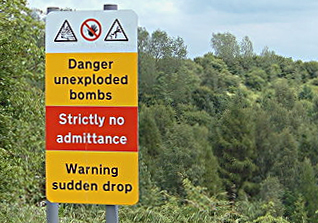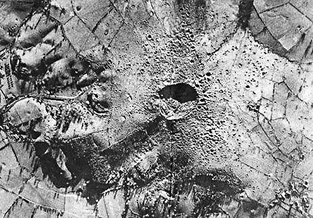| On the 27th November 1944 3,500 tons of high explosives and an estimated 500 million rounds of rifle ammunition exploded underground at the RAF's munitions dump at Fauld in Staffordshire. The likely cause of the explosion was a spark from the brass chisel being used by an airman on a live bomb - a tool that was not permitted, but probably made the job easier. This spark set off a chain reaction amongst the live munitions. A nearby farm and lime works were completely destroyed and virtually every house in Hanbury village was seriously damaged. A 6 million gallon reservoir was breached, the flood waters causing severe damage. Seismographs across Europe registered the blast. Had the blast occurred above ground, the effect would have been similar to that of the nuclear explosions at Hiroshima and Nagasaki. The official inquiry found that there were several systemic failings that had contributed to the accident: management of the site was poor, allowing dangerous work practices to exist. Suitable manpower had been in short supply, so Italian prisoners of war (200 of them) were being used to carry out menial tasks. Rescuers were met with confusion; no-one knew who was trapped underground because the required register wasn't maintained. Approximately seventy eight people were killed, mostly civilians in the nearby plaster works and local people. The crater is 90 feet deep and covers 12 acres. Despite the scale of the disaster, few people have heard of it. You can read more about the explosion at this local history website, and more images are available here. |
|
0 Comments
Leave a Reply. |
Archives
November 2020
Categories
All
|



 RSS Feed
RSS Feed